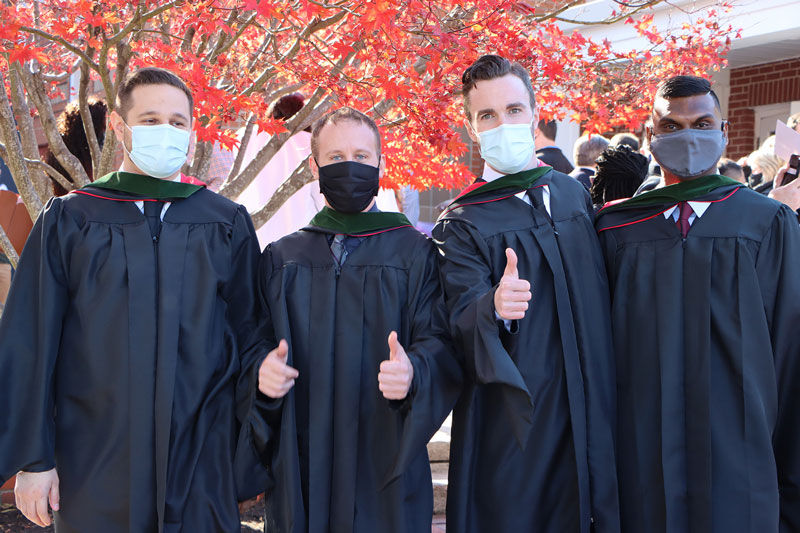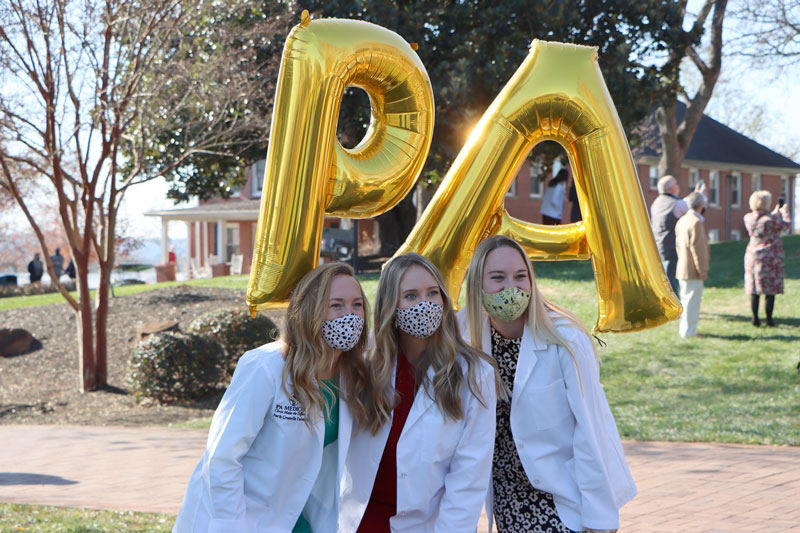
The North Greenville University Graduate School of Health Science at the T. Walter Brashier Graduate School held its annual white coat and hooding ceremony for the Master of Medical Science in PA Studies students on the Tigerville campus Friday morning, Dec. 11.
The white coat ceremony celebrates PA students’ successful completion of their didactic year. The hooding ceremony recognizes the Cohort of 2020’s accomplishments, which graduated from the program during commencement exercises that afternoon.
“When you think back to March 2020 and the rush to buy Clorox wipes and toilet paper, I’ll never forget the conversations I had with these students when they voiced their opinion that they wanted to stay in-person as long as they could. They didn’t want their didactic year interrupted,” said PA Medicine Program Director Dr. Jordan Hairr in his address to the Cohort of 2021. “Some of you parents may chuckle as you think back to when they were in elementary and middle school and fake sick not to have to go to school. Now, they tell me that they want to stay here in school in the middle of a pandemic. This speaks to their commitment. Their commitment to education, their commitment to their future goals, and to their future patients.”

During the white coat ceremony, the Cohort of 2021 was cloaked with a clinical white coat to commemorate their transition from didactic to clinical year. This group is the fourth cohort to enter the newly launched graduate degree program.
The didactic year is the portion of training where students learn about disease processes, the presenting signs/symptoms, physical examinations, clinical procedures, treatments, patient education, etc. Most of this occurs through traditional instruction in the classroom and small group settings. To complete the didactic year, students must maintain a 3.0 GPA and pass a cumulative assessment.
During the clinical year, the students begin to apply their knowledge through interacting with patients in collaboration with a clinical preceptor.
When addressing the Class of 2020, Hairr said that his high school principal talked about the word “stick-with-it-ness” at his graduation.
“He [the high school principal] said, ‘in order to be successful, you have to have stick-with-it-ness.’ There is no doubt that the Class that is graduating this year has shown some stick-with-it-ness, especially during this last year,” he said.
Hairr described many of the unexpected challenges the students faced.
“With all the unexpected twists around every corner, you remained flexible and worked very hard in demonstrating your stick-with-it-ness to becoming the best provider possible. The resiliency that you each had to exhibit and exhibited as a class is a testament to the quality of care you will provide your future patients,” Hairr said. “We are extremely proud of you and excited to call you our colleagues.”
Hairr described the make-up of the hood that the graduates would be receiving.
The candidates for holders of master’s and doctoral degrees wear hoods, which are the most expressive academic costume components. The hood represents a heavy burden and symbolizes the successful completion of the graduate program. The hood identifies the level of the degree, the field of learning, and the institution that awards it. The master’s hood is three and a half feet long and black, lined with the institution's colors conferring the degree. The hood is displayed down the back with the lining turned inside out. The velvet trim indicates the subject to which the degree pertains.
“The hoods worn by NGU’s graduating PA students are trimmed in green, which represents the study of medicine and symbolizes the original use of medicinal herbs,” said Hairr.
The PA Medicine degree program continues to attract increasing numbers of students to NGU’s Graduate School of Health Science. These ceremonies have become a yearly milestone for the school and are part of a growing trend.
The white coat recipients were Kaylee H. Adams, Rasmine A. Baker, Vladislav V. Balko, Lisa C. Barnes, Breanne L. Caffery, Robert A. Colletta, Olivia N. Ellgass, Caroline N. Franklin, Sydney C. Gettel, Anna N. Geurkink, John H. Ghrigsby, Justin E. Goff, Sarah K. Gutknecht, Aubrey S. Hestir, Andrea G. Joaquim, Ross A. LeClair, Jessica M. Lizio, Cheyenne C. Manning, Jordan D. Mattern, Olivia K. Meck, Hayley A. Meleason, Kelly C. Mills, Brittany S. Nielsen, Nia A. Peak, Kara D. Peschock, Tracy, L. Petrilli, V.E. Rose Scott, Ashley P. Theobald, Savannah T. Uldrick, and Rebecca L. White.
Members of PA Medicine’s graduating Class of 2020 are Taylor L. Adams, Deema M. Al-Ghandour, I. Grace Day, Ryan F. Chaya, Caitlin C. Christ, Lauren L. Combs, Joseph N. Dudding, Casey G. Eisenberg, Logan W. Ellis, Kaitlyn M. Freeman, Jacob E. Gardner, Madison K. Hamilton, C. Bo Hartman, Emily J. Hellesto, Jamie L. Iannace, Tori A. Jolly, Kimberly N. Kanupp, K. Marie Keiner, Cameron R. Lindler, Shayla V. McDonald, Jordan E. Miller, Anna Catherine C. Morris, Chelsea S. Navarro, Kayla D. Porter, Tess Quesenberry, Chad F. Staples, Kyle A. Thorne, Emily A. Wetzel, and Nicholas W. Wiseman.
To learn more about NGU’s Master of Medical Science in PA Studies, visit NGU.edu/pa-medicine or other graduate and online degree programs, visit NGU.edu/academics.